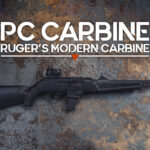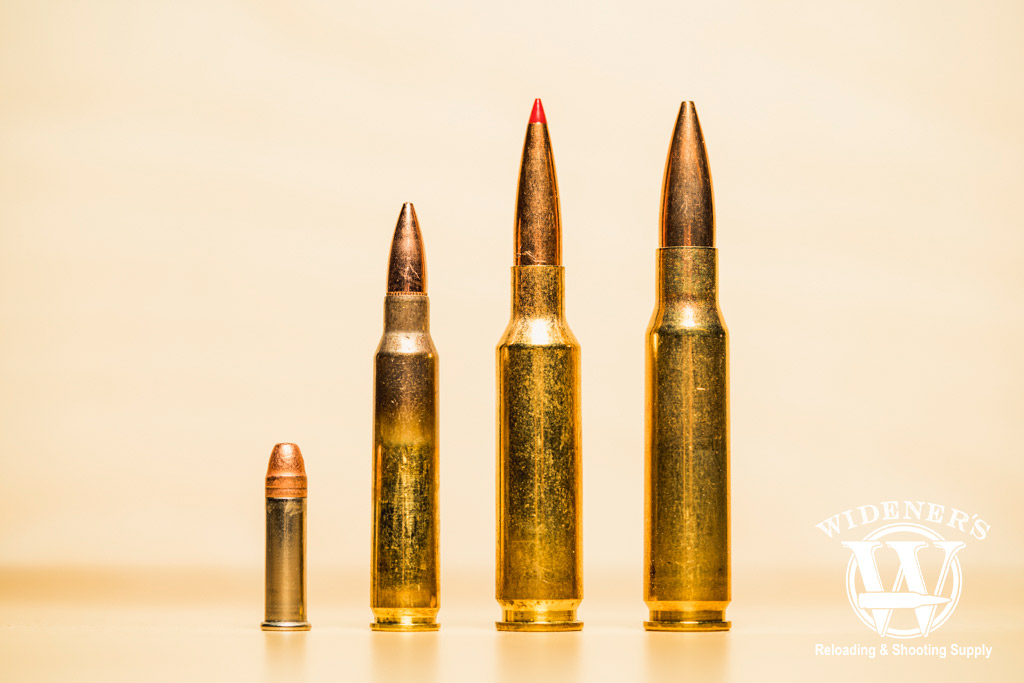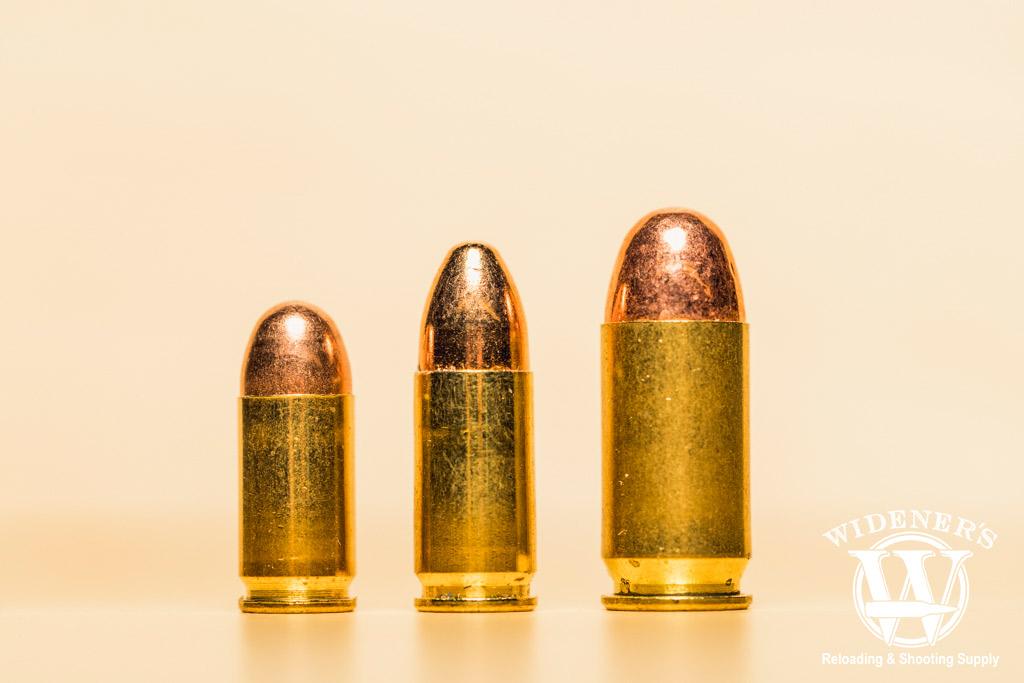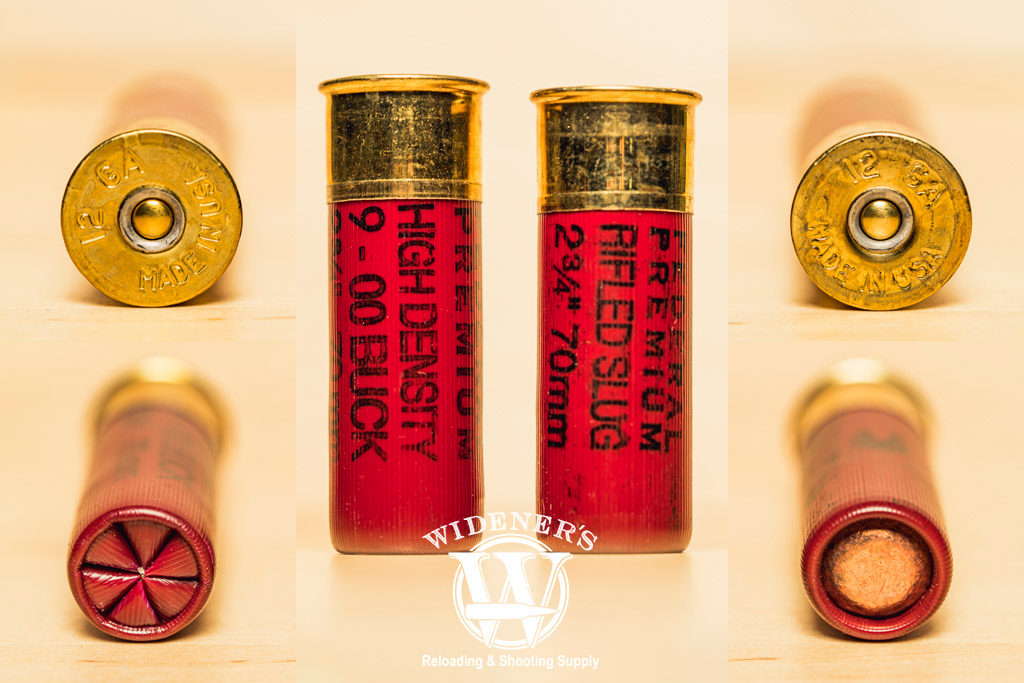

How fast do bullets travel? You’ve likely overheard other shooters discussing things like bullet velocity, penetration, or projectile trajectory. While these terms form a second language of sorts for seasoned shooters, these conversations can be a bit challenging to navigate if you are less well-versed on the subject of ballistics.
There’s no reason to sign up for next semester’s physics class at your local college to find out. Depending upon the caliber, a bullet can move anywhere from 400 to 4,600 feet per second. Trust us, there’s a lot more to bullet performance than just speed. We recommend that you keep reading to find out more.
Below, we’ll provide general information on the velocities of some of the most popular rifle, pistol, and shotgun cartridges. We’ll also define ballistic-related terms that you are likely to encounter next time you stumble across a bullet performance debate at the range.
Velocity Of Popular Rifle Calibers

Popular rifle calibers from left to right: .22 LR, .223 Remington, 6.5 Creedmoor, and .308 Winchester.
We’ll kick things off by discussing the muzzle velocity of four popular rifle calibers. How fast do bullets travel? Let’s dive in.
| Caliber | Bullet Diameter | Avg Weight | Muzzle Velocity | Muzzle Energy |
|---|---|---|---|---|
| .22 LR | .223″ | 30gr-40gr | 1,200-1,800 FPS | 130-220 FT LB |
| .223/5.56 | .224″ | 36gr-77gr | 2,500-4,000 FPS | 1,100-1,600 FT LB |
| 6.5 Creedmoor | .264 | 110gr-147gr | 2,500-3,000 FPS | 2,000-2,400 FT LB |
| .308 | .308″ | 110gr-180gr | 2,500-3,500 FPS | 1,800-3,000 FT LB |
.22 LR
First up on our list of rifle cartridges is the .22LR. It’s a rimfire cartridge, so technically it could also be on the pistol list. However, it remains one of the most popular rifle calibers in the world. Let’s take a look at Federal Champion Rimfire .22 LR, which has a 40-grain bullet with a lead round nose and a listed muzzle velocity of 1200 FPS. It may be small, but this precision bullet hits targets with 130 FT Lbs of energy which is more than enough for targets and handling varmints.
.223/5.56
For the .223/5.56 rifle caliber, we looked at two different rounds manufactured by Federal. The first is the 69 grain Gold Medal Sierra MatchKing .223 Rem. This high-quality cartridge has a muzzle velocity of 2950 feet per second, pushing 1330 FT LB of energy. The MatchKing series of cartridges are designed to deliver top match performance at long distances and are excellent for competition shooting scenarios.
The second .223 cartridge is the Power-Shok Rifle .223 Rem round. This hunting cartridge is significantly lighter at just 55 grains. However, it has a muzzle velocity of approximately 3,240 FPS and a jacketed soft point design. Its 1,282 FT LB of muzzle energy makes it a great option for putting meat on the table.
6.5 Creedmoor
Whether you love or hate the 6.5 Creedmoor phenomenon, there is no denying that the Creedmoor round has fantastic bullet ballistics, especially at long distances. For this article, we assessed the muzzle velocity of Federal’s 140 grain Gold Medal Berger 6.5 Creedmoor cartridge. This cartridge contains a Berger hybrid projectile and has a muzzle velocity of 2,725 FPS with 2,308 FT LB of muzzle energy. The Gold Medal cartridge has an impressive ballistic coefficient of .607 giving it a flat trajectory for hitting targets at a distance.
.308
When assessing the performance of .308 caliber cartridges, we turned our attention to PMC’s line of X-TAC ammunition. The 168 grain X-TAC .308 Win target shooting cartridge in particular. This OTM bullet has a listed muzzle velocity of 2,700 FPS, with a muzzle energy of 2,720 FT LB, and is great for target and match shooting applications. The OTM is hailed for its superior accuracy at long distances, which is why it is used across the globe by military and law enforcement personnel.
We also looked at Hornady’s American Whitetail .308 cartridge, which contains a 150-grain SP bullet. It has a muzzle velocity of 2,600 FPS with 2,251 FT LBS of muzzle energy. This cartridge caught our eye as it contains a soft-point bullet that is ideal for both bolt action rifles and modern sporting rifles. This hunting round provides superior expansion on impact with soft-targets, with minimal fragmentation, making it a great game cartridge.
Velocity Of Popular Pistol Calibers

How fast do bullets travel? Popular pistol calibers from left to right: .380 ACP, 9mm, and .45 ACP.
While we focused on target and hunting cartridges during the rifle segment, we shifted our attention to personal defense rounds for this section, as that is the type of performance data that is most important to most handgun owners.
| Caliber | Bullet Diameter | Avg Weight | Muzzle Velocity | Muzzle Energy |
|---|---|---|---|---|
| .380 ACP | .355″ | 45gr-115gr | 900-1,800 FPS | 200-350 FT LB |
| 9mm | .355″ | 90gr-147gr | 950-1,500 FPS | 300-500 FT LB |
| .45 ACP | .452″ | 125gr-255gr | 750-1,300 FPS | 300-650 FT LB |
.380 ACP
Federal manufactures several great defensive rounds chambered in .380 ACP. While not everyone is a huge fan of this caliber, if you carry a weapon chambered in .380 ACP, we strongly suggest investing in quality ammo. The best gun is the one that’s on you, so you might as well feed it something good.
First up is the Personal Defense Punch cartridge, which has a bullet weight of 85 and a muzzle velocity of 1,000 FPS with 189 FT LB of energy. It contains a jacketed hollow point projectile, which is designed to expand for self-defense purposes.
If a heavier round is more your style, the Personal Defense HST Micro .380 Auto cartridge is the way to go. This cartridge has a 99-grain hollow point projectile and a listed muzzle velocity of 935 FPS with 192 FT LB of energy. The HST bullets are designed to perform with reliability when passing through a variety of common barriers.
9mm
The 9mm cartridge is by far one of the most widely used handgun cartridges in the world. As a result, Federal and many other ammo manufacturers produce quite a few variants of this cartridge. Federal alone manufactures 10 different self-defense rounds chambered in 9mm. However, we once again focused on just two of their top options for this article.
First, we looked at the Personal Defense HST 9mm +P round, which has a 124-grain projectile and a muzzle velocity of 1,200 FPS. This spicy round pushes almost 400 FT LBS of muzzle energy, making it very attractive for concealed carry. HST ammo is designed for reliable penetration and expansion through a variety of common barriers.
Next is up is the Hydra-Shok 9mm Luger cartridge. This larger cartridge has a bullet weight of 147 grains, a muzzle velocity of 1,000 FPS and contains a jacketed hollow point projectile. The Hydra-Shok pushes about 330 FT LBS of muzzle energy. The inner-post bullet design dates back to the 1980s. It remains a popular round for self-defense.
.45 ACP
If you like your pistol ammo on the thick side, the .45 ACP may be more your style. Federal’s variant of the Personal Defense HST .45 ACP cartridge contains a much heavier projectile that comes in at 230 grains. However, its muzzle velocity of 890 FPS with 404 FT LBS of muzzle energy makes it ideal for close-quarters self-defense. HST ammo is part of Federal’s premium line of ammo, designed for consistent expansion and penetration.
The 230-grain Hydra-Shok .45 ACP cartridge is slightly faster, with a muzzle velocity of 900 FPS. It contains a jacketed hollow point projectile that pushes about 425 FT LB of muzzle energy. The Hydra-Shok center-post JHP bullet is known for its reliable expansion, making it a popular self-defense option.
Velocity Of Shotgun Shells

Popular 12-Gauge shotgun ammo from left to right: 12-Gauge 00 Buckshot, and 12-Gauge Rifled Slug.
We’ll round out our popular caliber breakdown by taking a look at the muzzle velocity of 12 Gauge 00 Buck and Slugs.
| Caliber | Bullet Diameter | Weight | Muzzle Velocity | Muzzle Energy |
|---|---|---|---|---|
| 12-Gauge 00 Buck | .33″ (9 Pellet) | 52gr-54gr | 1,200-1,600 FPS | 1,500-2,000 FT LB |
| 12-Gauge Slug | .690″ | 300gr-450gr | 1,200-1,800 FPS | 2,000-3,200 FT LB |
12 Gauge 00 Buck
For this shotgun gauge, we chose the Federal Premium Personal Defense Shotshell Force X2. This shotshell contains nine copper-plated lead projectiles with a muzzle velocity of 1250 FPS. The pellets measure .33″ in diameter and provide muzzle energy of around 185 FT LB. Although each pellet may be smaller in diameter than a .380 ACP bullet, nine of them coming at you at 1,250 FPS will do some considerable damage. Shotguns are generally considered most effective as CQB weapons with a limited range, but devastating results.
12 Gauge Slug
Federal’s Trophy Copper Sabot Slug is the cream of the crop when it comes to high-performance slug shotshells. This shotshell boasts a 300-grain projectile and a peak muzzle velocity of 1900 FPS. That’s an impressive 2,405 FT LBS of muzzle energy for those of you keeping score. The sabot slug facilitates a sub-4-inch grouping at up to 200 yards when paired with a rifled barrel. It’s a big hunk of metal, guaranteed to put a hole through anything within range. Hunters like it for dropping game quickly, police departments and federal agencies rely on it for ending threats.
Understanding Bullet Performance
Let’s recap a few common ballistic terms as they relate to the world of firearms.
Ballistics
Ballistics is a field of science that involves the study of how projectiles travel while in flight. The study of the path of the projectile can be divided into three categories, which include its travel through the barrel, its flight while in open air, and its pathway upon impact (penetration).
Muzzle Velocity
In the realm of physics, velocity is often defined as follows: “the rate at which an object changes its position.” To put things more simply, muzzle velocity refers to how rapidly a bullet is moving away from the barrel of your weapon and towards your target. The velocity of a bullet is almost exclusively expressed in terms of FPS or feet per second.
Naturally, the velocity of a bullet diminishes as it travels through the air due to a variety of factors. Therefore, bullet velocity is typically measured when it exits the barrel of a weapon. Other factors like bullet weight and barrel length can affect muzzle velocity.
Muzzle Energy
When a bullet leaves the barrel of a firearm, its kinetic energy is discharged. This kinetic energy is commonly called muzzle energy and is an indication of the destructive potential of the bullet. The greater a projectile’s muzzle energy, the greater the possibility of catastrophic damage to the intended target. Muzzle energy is measured in units of foot pound force recorded as FT LB.
Trajectory
Generally speaking, the term “trajectory” refers to the flight path of a bullet or other projectile in relation to a fixed point. When discussing the trajectory of bullets, the fixed point is always the end of a weapon’s barrel.
Virtually all small arms projectiles have a parabolic-shaped trajectory. This means that the bullet’s pathway from the barrel to the target has a curve or U-shape. However, this curve is negligible unless shooting at great distances. The curved trajectory is caused by a combination of gravity and air resistance, both of which impact the flight of the bullet once it leaves the barrel of the weapon.
When you zero a scope or other optic, you are accounting for the influence of these factors so that you can accurately put rounds on target at a specified distance.
What Influences Bullet Performance?
As noted above, there are several confounding factors that can impact the muzzle velocity of a particular cartridge. When discussing how fast do bullets travel, these factors should be included:
- Bullet Type (I.e., FMJ, Hollow Point)
- Bullet Weight (Grain Weight)
- Amount of powder used
As a result, bullets of the same caliber will have various muzzle velocities depending on which company manufactured it. To further complicate matters, most ammunition companies manufacture multiple variations of popular calibers. For instance, Federal Premium Ammunition has ten different categories of rifle ammunition listed on its website.
For simplicity’s sake, we limited our guide to only one or two variations per caliber. Specifically, most of the cartridges listed above are manufactured by Federal Premium Ammunition, as this is one of the largest and most popular ammunition companies in the world.
How fast do bullets travel? Virtually all ammunition manufacturers list muzzle velocity data on their website so that you can easily locate this information if your go-to cartridge is produced by a different company. It’s a quick and easy way to answer the question for yourself.
Recap: How Fast Do Bullets Travel?

How fast do bullets travel? Generally, velocities range from 400 to 4,600 feet per second.
How fast do bullets travel? Hopefully, you have your answer and a better general understanding of ballistics. If you’re a new or experienced gun owner, there’s always something new to learn when it comes to ballistics. Understanding muzzle velocities of the most common rifle, shotgun, and handgun cartridges will make you a more informed gun owner. If you want to learn more about the world of firearms, be sure to check out our other guides, such as What Is Bullet Weight?


